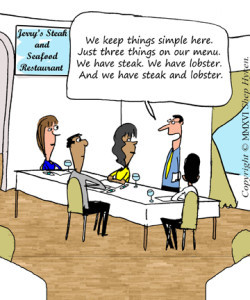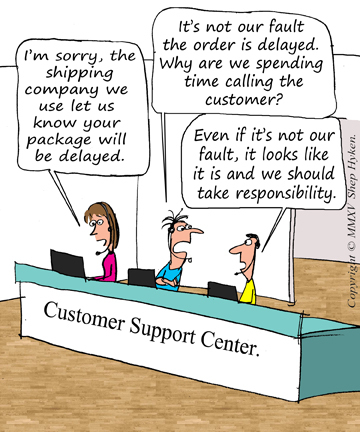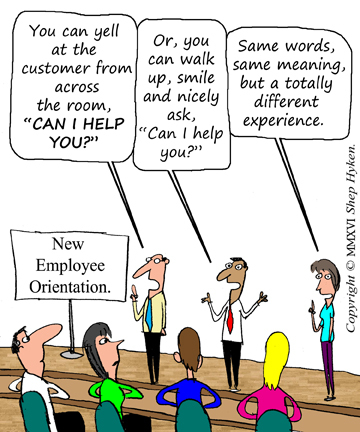Shep Hyken's Blog, page 196
January 20, 2016
Simplicity: Another Customer Experience (CX) Strategy
 Competitive Advantage
Competitive AdvantageSimple is simple. Simple doesn’t always mean easy. And, sometimes simple is actually hard to pull off. But some companies have mastered the art of simplicity. And, in doing so, they created customer experiences that are easier, frictionless, and more desirable.
Siegle+Gale recently released their Global Brand Simplicity Index, and, for the third straight year, Aldi, the grocery store chain, ranked first – or should I say simplest. The grocer won this honor because of a number of things, but most notably for their “uncomplicated offers.”
So, I started thinking about the experiences that I’ve had that are simple. I remember going to a The Homestead, a restaurant in upstate New York. There weren’t menus. They didn’t need them. I’ll never forget what the server said when it was time for us to order. She said, “We have three things that we serve at The Homestead. We have steak. We have lobster. And, we have steak and lobster.” She added, “Let me know if that doesn’t appeal to you and we’ll find something else for you.”
It doesn’t get much simpler than that.
You may be familiar with In-N-Out Burger. This is the hamburger chain that is known for high quality, fresh burgers and fries. And, by the way, other than drinks, which include soft drinks and milk shakes, that’s all they serve; burgers and fries. Of course you can add a slice of cheese to the burger, but what you won’t find is a chicken sandwich or any other option that takes away from the beautifully simple concept of In-N-Out Burger.
Chic-fil-A is another example. They expanded from chicken sandwiches to chicken wraps and salads with chicken. What you won’t find is a hamburger.
Ted Drewes is a frozen custard stand that sells… frozen custard. Nothing else. You can’t get regular ice cream. You can’t get gelato. You can only get desserts with frozen custard. If you want a piece of chocolate cake for dessert, you’ll have to go somewhere else.
MetLife created “insurance in a box.” I wrote about this a few years ago. I can’t speak to the success of the product, but MetLife did create a super-simple way to buy life insurance. You go to Walmart, take the box, which clearly states the details of a very simple life insurance policy, to the cashier, pay for it, and go home and register. The goal was to create the simplest way to buy life insurance, ever.
Think about how easy it is to buy something on Amazon.com. Once you set up your account, you can find an item you want and use their “one-click” check-out process. Just one click and you’ve bought it. Simplicity at the highest level.
Simplicity can enhance the customer experience and give you a competitive advantage. What else do you need to be convinced to take a look at the experience your customer has with you, and where you can simplify the process?
Shep Hyken is a customer service expert, keynote speaker and New York Times bestselling business author. For information contact or www.hyken.com. For information on The Customer Focus™ customer service training programs go to www.thecustomerfocus.com. Follow on Twitter: @Hyken
(Copyright © MMXVI, Shep Hyken)
The post Simplicity: Another Customer Experience (CX) Strategy appeared first on Shep Hyken.
January 19, 2016
Amazing Business Radio: Govindh Jayaraman
 January 19: Govindh Jayaraman: Your Five Step Plan for Life and Business Success
January 19: Govindh Jayaraman: Your Five Step Plan for Life and Business Success
Shep Hyken discusses creating a plan for success in your personal life and in business, with Govindh Jayaraman. In his new book “Paper Napkin Wisdom: Your Five Step Plan for Life and Business Success,” great leaders share pearls of wisdom simply and briefly – on a Paper Napkin. Govindh’s goal is to show people everywhere how they can be successful, and change the world in the process. So if you want to make a change for the better, listen to Govindh share wisdom he’s learned from top entrepreneurs, leaders, and difference-makers.
Click here to listen and subscribe to Amazing Business Radio on iTunes.
“If you can’t explain it simply, then you don’t know it well enough.” – Govindh Jayaraman
The post Amazing Business Radio: Govindh Jayaraman appeared first on Shep Hyken.
January 18, 2016
5 Top Customer Service Articles For the Week of January 18, 2016
Each week I read a number of customer service articles from various online resources. Here are my top five picks from last week. I have added my comment about each article and would like to hear what you think too.
Using Service as a Competitive Advantage: 5 Ways to Help Customers Love You by Shuly Oletzky
(Huffington Post) There’s a big issue when it comes to customer service — many companies simply don’t provide it, and this is great news for those who do.
My Comment: Who doesn’t want their customers to love them? Here’s some great tips on how to deliver the service that your customers will love.
Customer service best practices: Making social media a two-way conversation by Stephanie Walden
(Mashable) When it comes to your business’ customer service strategy, social media can simultaneously be your brand’s most valuable ally and its most intimidating nemesis.
My Comment: Outstanding article with some excellent tips on social customer service. I especially like number six, differentiating customer service and crisis management. And number two is a great reminder to answer social complaints or questions in a timely manner. (On average, the customer expects – or maybe a better word is hopes – the request, question or complaint will be answered in under an hour.)
The Customer Isn’t Always Right – Here’s Why by Vivek Patel
(Startup Grind) While the phrase was coined in the retail sector, if you’re in business today you must have heard the phrase, “the customer is always right.” Coined by Harry Gordon Selfridge in 1909, the popular phrase was used as a slogan by Selfridge’s London department store, giving customer satisfaction the highest priority. Over 100 years later, businesses are still using this motto to convince customers they are receiving the best possible value for their money.
My Comment: Love this article! I’ve always believed that the customer is NOT always right. But, they are always the customer. So, let them be wrong with dignity and respect. Unless it’s not about them being wrong, and it’s about them exhibiting the wrong behaviors, such as being extremely rude or abusive. That’s when you have to decide if that customer is worth keeping. And if you “fire” your customer, always try and keep the door open. Some customers will regret their behavior and want to come back. It always makes good sense to end a relationship the best way you can.
My Predictions For Customer Experience in 2016 by Vit Horky
(Brand Embassy) To help us — the dreamers, the thinkers, the doers and the innovators— through The Year of the Emotional Customer, here are my four predictions for customer experience in 2016 and how Brand Embassy is helping make this a reality.
My Comment: What’s going to be important to your Customer Experience strategy in 2016? Read this article to find out. My favorite of the four predictions is number one, which focuses on the emotional side of the experience.
5 Social Customer Service Resolutions for 2016 by Infinit Contact
(Infinit Contact) Whether you already have a plan in place or just starting to draw up a list of resolutions, here are a few social customer service areas to focus on.
My Comment: I’m surprised more companies haven’t put a social media customer service strategy to work for them. If you have, then you’ll get some great reminders. If you haven’t, this will give you some food for thought. In short, this is a great article with some excellent reminders and tips on how to deliver better social media customer service.
Shep Hyken is a customer serv ice expert, professional speaker and New York Times bestselling business author. For information contact or www.hyken.com . For information on The Customer Focus™ customer service training programs go to www.thecustomerfocus.com . Follow on Twitter: @Hyken
The post 5 Top Customer Service Articles For the Week of January 18, 2016 appeared first on Shep Hyken.
January 15, 2016
Guest Blog: Creating Customer Service Power Through Increased Adaptability
This week on our Friends on Friday guest blog post my colleague, Tony Alessandra, writes about the importance of adaptability as it relates to customer relationships and managing different situations around you. It is important to be adaptable so you are able to deal with any customer or situation that comes along. – Shep Hyken
As customer service reps and salespeople begin to learn about any new topic related to amazing customers, they may jump to oversimplified and incomplete conclusions. When that happens, they are often less successful than is possible. But with continuing effort, thought, increased study, and personal one-on-one coaching, they eventually graduate to a higher level of customer service excellence. In terms of behavioral adaptability, this means it is essential for us to understand these three following principles:
Adaptability is not a goal in and of itself, but a means to the end of increased personal effectiveness and success.
A key to effectiveness is to realize what level and type of adaptability component(s) are the critical factors in achieving a targeted goal.
Being adaptable also means assessing the other available resources that can allow you to get your desired outcomes by acting smarter.
Adaptability, then, is important because it directly relates to your degree of achieved success in relationships with other people, to coping with changing conditions around you, to managing different types of situations.
Extreme behavior can raise others’ tensions
At times people may perceive extreme adaptability as acting wishy-washy, sashaying back and forth across the fence line, or acting two-faced. Additionally, a person who maintains high adaptability in all situations and relationships may not be able to avoid personal stress. This is usually temporary and may in fact be worth it if you gain rapport with the other person.
The other extreme of the continuum is little or no behavioral adaptability. This causes people to view someone as rigid and uncompromising – on behaving at his own pace and priority.
Adaptability is important to successful relationships of all kinds. People often adopt at least a partially different role in their professional lives than they do in their social and personal lives. This is to successfully manage the professional requirements of their jobs. Interestingly, many people tend to be more adaptable at work with people they know less and less adaptable at home with people they know better. Why? People generally want to create a good impression at work, but at home may relax and act themselves to the point of unintentionally stepping on other family members’ toes. Not an attractive family portrait, but often an accurate one.
Adaptability works
Effectively adaptable people meet the key expectations of others in specific situations—whether it’s in personal or business relationships. Through attention and practice, you can achieve a balance of strategically managing your adaptability by recognizing when a modest compromise is appropriate. You’ll also understand when it’s necessary to adapt to the other person’s behavioral style.
Practice managing relationships in a way that allows everyone to win. Be tactful, reasonable, understanding, non-judgmental, and comfortable to talk to. This results in a moderate position between the two extremes. You’re able to better meet the needs of the other person as well as your own. Adapt your pace and priority. Work at relationships so everybody wins at work, with friends, on dates, and with family.
When you try to accommodate the other person’s expectations and tendencies, you automatically decrease tension and increase trust. Adaptability enables you to interact more productively with difficult people, helps you in strained situations, and assists you in establishing rapport and credibility. It can make the difference between a productive or an ineffective interpersonal relationship. And your adaptability level also influences how others judge their relationships with you. Raise your adaptability level—trust and credibility soar; lower your adaptability level—trust and credibility plummet.
Another way of looking at this whole matter is from the perspective of maturity. Immature customer care professionals, on the other hand, lose effectiveness in dealing with the real world when they lock into their own style. By disregarding the needs of others, they end up causing conflict and tension that lead to less satisfaction and fulfillment in their life environments. Mature customer care professionals know who they are. They understand their basic DISC behavioral type and freely express their core patterns. However, when problems or opportunities arise, they readily and deliberately make whatever adjustments are necessary in their core patterns to meet the needs of the situation or customer relationship.
Dr. Tony Alessandra is the author of 30 business books and Founder of Assessments 24×7 LLC, a company that offers a variety of online assessments
For more articles from Shep Hyken and his guest contributors go to customerserviceblog.com . Read Shep’s latest Forbes Article:
The post Guest Blog: Creating Customer Service Power Through Increased Adaptability appeared first on Shep Hyken.
January 13, 2016
What to Do When You Don’t Have Control Over the Customer Experience
 Solving Customer Problems
Solving Customer ProblemsWhat happens when the customer calls about a problem, but the problem is completely out of your control?
Let’s use an online retailer as an example. The customer buys a product and requests it be shipped via one of the typical shipping companies like UPS, FedEx or USPS. The product goes out right away, but the shipping company fails to deliver on time. The customer calls the company and is obviously upset. Why was there a delay? Maybe it’s a weather problem that caused the shipment to arrive late. Or, maybe it was just a glitch in the shipping company’s system. Regardless of the issue, it was completely out of the seller’s control. Not their fault, but that doesn’t mean that they can’t take responsibility.
One other quick example, and this one came from one of our subscribers, Brad Mifsud in Australia. He has a law firm that specializes in real estate. Sometimes, in preparation for a “closing,” which is when all of the papers are signed and the property officially changes ownership, there can be delays due to the bank or some other party not delivering their paperwork on time. Whose fault is this? Brad’s law firm, as good as it might be, has no control over the employees at other companies who may not act with the same urgency to meet deadlines as his firm does.
In both of these examples, the company and law firm had no control of the situation. Yet to the customer or client, it looks like they were at fault. So, what can a company do?
The answer has two parts: proactivity and communication.
Proactivity means you find out the information before the customer does. For example, technology allows for packages to be tracked and alerts sent if there are delays. You’ll know there is a delay before the customer does. Or you check with the bank to make sure all of documents will be processed on time, well before they are due. If for any reason there is a problem with delays (in both of these examples) it’s time to move into part two, which is to communicate with the customer.
Let the customer know as soon as possible about any problems. Even though they may not be your fault, many times they will appear to be your fault. It’s not your job to deflect blame. It’s your job to let the customer know you’re on top of it. You can email the customer and explain that because of a snow storm, there is a delay and when they can expect their package. A simple phone call can be made to let the client know that certain papers are being held up at the bank for whatever reason and that you’re aggressively working with them to get the problem taken care of.
Once you communicate, even if the customer isn’t happy with whatever the issue is, they will know that you’re aware and on top of the situation. You’re working to resolve an issue that isn’t even your fault. The customer will appreciate this effort. It’s a Moment of Misery™ that turns into a Moment of Magic®!
Shep Hyken is a customer service expert, keynote speaker and New York Times bestselling business author. For information contact or www.hyken.com. For information on The Customer Focus™ customer service training programs go to www.thecustomerfocus.com. Follow on Twitter: @Hyken
(Copyright © MMXVI, Shep Hyken)
The post What to Do When You Don’t Have Control Over the Customer Experience appeared first on Shep Hyken.
January 12, 2016
Amazing Business Radio: Ford Saeks
 Ford Saeks Shares Tips on Social Media, Dominating Search Engines, and Generating the Right Leads
Ford Saeks Shares Tips on Social Media, Dominating Search Engines, and Generating the Right Leads
Shep Hyken discusses attracting more loyal, repeat customers and leveraging social media with speaker, author, and growth innovator, Ford Saeks. Ford shares some expert tips on dominating search engines and generating leads that convert into loyal customers. These tips will help you expand your reach, build your database, and make more money.
Click here to listen and subscribe to Amazing Business Radio on iTunes.
“If you listen to what your customers want, and you’re answering the questions they have, they’ll love you for it.” – Ford Saeks
The post Amazing Business Radio: Ford Saeks appeared first on Shep Hyken.
January 11, 2016
5 Top Customer Service Articles For the Week of January 11, 2016
Each week I read a number of customer service articles from various online resources. Here are my top five picks from last week. I have added my comment about each article and would like to hear what you think too.
In the Spirit of Dr Seuss – A Customer Experience Holiday Poem by Sven-Olof Husmark
(CustomerThink) The poem’s general message can serve as food for thought moving into 2016 – Give your customers want they want – smooth and seamless journeys.
My Comment: This is a very clever way to promote a message – or a lesson. It’s a short poem that was written just before the holiday season about giving customers what they want, which is a smooth and painless experience.
16 Effective Things You Must to Do in 2016 – for Hospitality People by Rupesh Patel
(LinkedIn) What are your major goals and plans for this new year? Is it to be a better person or to learn something new? Or could it be to once-and-for-all, drop that bad habit you put on last year’s resolution list. Here are some reasons why you may have procrastinated.
My Comment: Even though the title of this article mentions it is for “hospitality people,” you don’t have to be in hospitality for most, if not all, of these ideas to work. Everyone who has a customer-facing responsibility should have a hospitality mentality.
58 Customer Experience Quotes From 52 Weeks of Podcasts by Tema Frank
(Frank Reactions) This collection includes quotes from people like: Jay Baer, Jeanne Bliss, Kerry Bodine, Pat Flynn, Lynn Hunsaker, Shep Hyken, Jerry Manus, Bruce Temkin and many more!
My Comment: Great article about why we should love to get complaints from our customers. Complaints are opportunities to show your customer how good you are by how you resolve them. A good complaint can change the way you do business. (Sometimes complaints are a customer’s way of giving advice and feedback – that is valid.) Complaints are our friends!
Why a Complaining Customer is Good for You! by Sourov Roy
(LinkedIn) The better way in my opinion, is to use this opportunity to actually get the customer satisfaction level back up from this slump.
My Comment: Here are 58 excellent quotes around the topic of customer experience. They are perfect to use as conversation starters for your next team meeting.
Customer Retention for Agencies: 6 Tips on Keeping Clients for the Long Haul by Erin Sagin
(WordStream) If you want to run a successful digital marketing agency, your #1 job is to foster a group of happy, long-term clients. Unfortunately, this can be quite a daunting feat.
My Comment: This article is written from the perspective of a digital ad agency who wants to retain clients. However, with a little thought, these tips are appropriate for all types of businesses in any type of industry. I don’t think anyone would be unhappy with more loyal clients (or customers, guests, etc.).
Shep Hyken is a customer serv ice expert, professional speaker and New York Times bestselling business author. For information contact or www.hyken.com . For information on The Customer Focus™ customer service training programs go to www.thecustomerfocus.com . Follow on Twitter: @Hyken
The post 5 Top Customer Service Articles For the Week of January 11, 2016 appeared first on Shep Hyken.
January 8, 2016
Guest Blog: Commandments to Build Customer Advocates for Your Small Business
This week on our Friends on Friday guest blog post my colleague, Mike Schoultz, shares great ideas on what you can do to create customer advocates for your business. Customer advocates can only help our business and create important loyalty.– Shep Hyken
Here is a simple but powerful rule – always give people more than they expect. – Nelson Boswell
Customer evangelism is something companies and marketing agencies have talked about for years. Often though, big companies get all the attention in this area. I am about to tell you how to build customer advocates for your small business. But first, I need to ask you an important question.
How often, as a customer, do you experience WOW customer service … the type that you normally can’t imagine? Average or less customer service seems like the norm in many small businesses. In some it’s so common that when we provide great service, we yield customers who feel like they’ve won the lottery, if only for a moment. But it doesn’t have to be that way. Customer service tips to create customer advocates are not rocket science.
We often get a questions and comments on customer service from clients and people commenting on our blog. Many relate to customer service actions that are reminders of what we already know (but we occasionally forget). These are bid enablers of customer service. They usually won’t create WOW service on their own, but their absence is noted by customers and makes excellent customer service just good or less.
Related: How Marriott Courtyard Turned Customer Failure into Service Recovery
As we work with companies to help them in improving customer service and creating customer advocates, some things stand out. These are things a lot of small businesses don’t do consistently. Yet if they did they’d find the quality of their customer service would improve and their customer loyalty would increase.
Here are seven things you can do to create customer advocates no matter what size your company is.
Talk to your customers
Have real person-to-person conversations with as many customers as you can. If you have a lot of customers relative to your employees, then you’ll need to prioritize. Find ways to have real, meaningful and ongoing conversations with them. Your goal is to make a friend and start a relationship.
Seek first to understand
When a customers are telling you their issue, give them your complete attention. Customers consistently tell us they hate dealing with employees who don’t listen, pay attention, or don’t seem to care.
Serve their needs
Of course you’re doing this to make your company better. But everything you do in your customer evangelism effort needs to be useful from your customer’s perspective. Educate them while you engage them. Always do things in ways that are useful to and respectful of your customers. Keep that as your primary focus.
Always greet customers promptly and with a smile
When talking with a new customer, give them your full name and get theirs right away. This makes your conversation more personal and enables you to better connect with your customer.
It also tells your customer you’re willing to be accountable for helping them because if you don’t, they know who you are!
Remember one thing
Remember one thing about each customer you meet. People do business with people. Make your actions personal. Customers should want to do business with you because of you and your employees. Make your customers “feel at home.” You may have a great location, cool displays, great signage, etc. That’s all great, but if your people can’t make your customers feel welcome and appreciated, all of the other doesn’t matter.
The bottom line
Your job as a businessman is simple. It is not just to create a customer; it is to create a customer who also creates customers.
Mike Schoultz is a writer, digital marketer, and owner/operator of a small consulting agency. He loves helping small businesses improve their success. He is on his third career, so his biggest goals are making a difference in these businesses. You can connect with him on LinkedIn, Twitter @mikeschoultz, G+, or his agency website Digital Spark Marketing.
For more articles from Shep Hyken and his guest contributors go to customerserviceblog.com . Read Shep’s latest Forbes Article:
The Year Of The Customer: 16 Customer Service And Experience (CX) Trends For 2016
The post Guest Blog: Commandments to Build Customer Advocates for Your Small Business appeared first on Shep Hyken.
January 7, 2016
Amazing Business Radio: Dennis Snow
 January 7, 2016: Dennis Snow Shares Tips From Disney on Achieving Exceptional Customer Service
January 7, 2016: Dennis Snow Shares Tips From Disney on Achieving Exceptional Customer Service
Shep Hyken speaks with Dennis Snow, professional speaker, bestselling author of “Lessons from the Mouse” and a man with a passion for service excellence. His abilities were born and developed while working at The Walt Disney World Company. Dennis shares his tips from Disney on how to provide exceptional customer service incorporating the entire customer journey into the customer service experience.
Click here to listen and subscribe to Amazing Business Radio on iTunes.
“Keep the dirty laundry in house (backstage), when we air it in front of the customer we diminish the brand.” – Dennis Snow
The post Amazing Business Radio: Dennis Snow appeared first on Shep Hyken.
January 6, 2016
The Secret to Asking Questions Correctly
 Customer Experience
Customer ExperienceMy buddy Gary Chervitz just came back from Las Vegas. He was excited to share a customer service story with me. He prefaced it by saying it may not sound like a big deal, but after he told me what happened, I told him that while it may not be a big deal, it was still extremely important and worth sharing.
Gary was at a restaurant and almost finished with his meal. He had set his fork and knife down. The server noticed he had stopped eating, yet there was still a little food left on the plate. He asked Gary, “Are you continuing to enjoy your meal?” Gary acknowledge with a simple, “Yes,” and the server came back later, after Gary had obviously finished, and took his plate.
What impressed Gary was not that the server was polite and obviously very good at his job. It was the server’s question. The actual words he used, “Are you continuing to enjoy your meal?”
What made that question stand out was what happened after talking to Gary when I went to dinner with my wife. Toward the end of the meal the server came over and asked, “You still working on that?”
I never really thought about that question before – until that night. I replayed the conversation Gary and I had earlier that day. I contrasted the two servers’ questions. Both servers’ intentions were the same, to take care of us. It’s just the language they used. One was polite – even classy and sophisticated. The other, in comparison, was a little “raw.”
Again, I’d never thought much about this before. Servers have asked questions such as, “Can I take your plate?” or “Are you finished?” They are just doing their job. Even, “Are you done with that?” isn’t bad. Until you compare it to the classiness of, “Are you continuing to enjoy your meal?”
Let me share another example. I’m sure you’ve walked into a retail store and a salesperson came up to you and with a friendly smile, welcomed you and asked, “Can I help you?”
Compare that with what my friends at Ace Hardware train their people to say as a greeting. Again, with a friendly smile and warm greeting, the salesperson asks, “What can I help you find today?”
Totally different ways to ask the same question, even though you may get the same answer. Yet the customer experience is enhanced by the way the question is asked. In the restaurant, it is classier. In the retail store, it’s a friendlier open ended question.
The secret to having people ask the right questions – in the right way – is training. Create the right question, describe the scenario, even consider role playing the scenario, and then practice it. Training and reinforcement. That’s the key to getting the people to phrase questions, responses and statements the way they should be made.
It’s all in how you say it.
Shep Hyken is a customer service expert, keynote speaker and New York Times bestselling business author. For information contact or www.hyken.com. For information on The Customer Focus™ customer service training programs go to www.thecustomerfocus.com. Follow on Twitter: @Hyken
(Copyright © MMXVI, Shep Hyken)
The post The Secret to Asking Questions Correctly appeared first on Shep Hyken.



